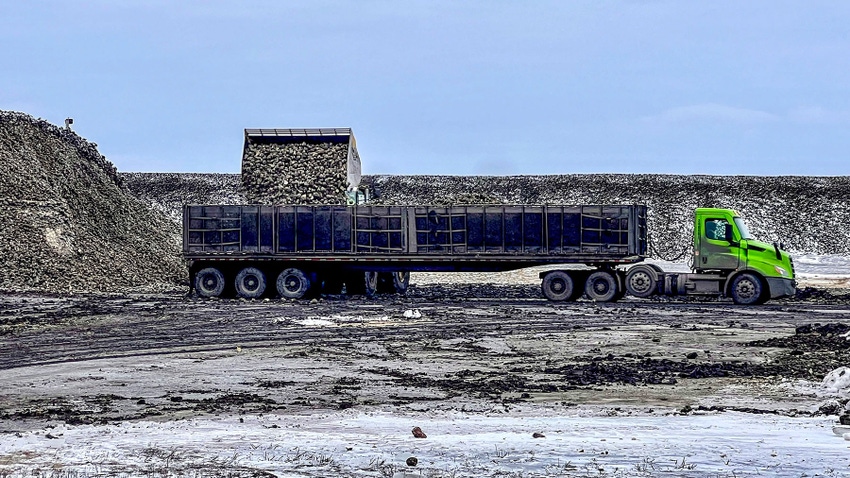March 5, 2024

by Adam Kuznia
“It’s not a popular opinion, but I would welcome a late-season snowstorm,” says Cory Kritzberger, ag operations manager at American Crystal Sugar Co., based in Moorhead, Minn.
For most Red River Valley folks, El Niño brings a favorable change from normally frigid winters. But for a sugarbeets, abnormally warm temperatures are not so welcome.
The best way to store sugarbeets is to freeze them soon after harvest. To accomplish this, American Crystal aims to run cooling fans for 450 to 600 hours on ventilated piles as soon as the temperature drops below zero degrees F, typically in early to mid-December.
This year, above-average temperatures kept cooling fans idle until Jan. 8, the latest Kritzberger has seen in his 28 years of experience.
To prevent spoilage, American Crystal wants the tops of ventilated piles to reach zero degrees before blanketing the sugarbeets with tarps until late spring, when they are ready to be trucked to factories for processing.
Through Feb. 23, American Crystal’s piling sites remained at least 100 fan hours short of their goal, leaving the peaks 10 to 15 degrees higher than preferred. This forced Kritzberger and his team to experiment with newer practices, such as using a bulldozer to remove the top 2 feet of some piles before covering them.
Scraping the tops disposed of 60,000 tons, or less than 1% of the company’s 12.6 million tons. Removing the upper layer prevents hotspots that can cause much more spoilage.
“Imagine putting an apple in the freezer before bed at night. The next morning, you take it out and put it on the counter before leaving for work. By the time you get home, that apple will be disappointing. Sugarbeets react similarly when storage temps fluctuate,” Kritzberger explains.
And like an apple, one lousy sugarbeet spoils the bunch.
In the valley’s southern end, at Minn-Dak Farmers Cooperative in Wahpeton, N.D., Mike Metzger faces the same challenges. Metzger, vice president of agriculture and research, says Minn-Dak hasn’t discarded any beets yet, but he remains concerned about future risks.
“We are holding our own, but we understand that things can take a turn for the worse very quickly. That’s why we are relying more on technology to monitor the condition of the piles,” Metzger says. He refers to temperature sensors placed under the tarps and drones equipped with thermal cameras that fly at night to detect hotspots before they spread and infect large areas.
Detecting early hotspots allows the team to vent the heat from the tarps before hauling the pile to the factory, helping avoid unnecessary processing costs due to sugarbeet spoilage.
Good ’23 crop
Minn-Dak and American Crystal growers achieved phenomenal yields last year despite late planting, thanks to favorable weather and genetic advancements in seed.
Though the large crop forced growers to leave a small percentage of unharvested beets in the field, Kritzberger says American Crystal hit the sweet spot in 2023, producing enough sugarbeets to operate factories at total capacity.
According to Kritzberger, even a 2 million-ton smaller crop wouldn’t solve heat-related storage issues, so producing a large crop is more of a blessing than a hindrance.
Optimism for ’24
Despite concerns about processing the remaining third of the 2023 crop, Metzger and Kritzberger are optimistic for the 2024 growing season.
Planting sugarbeets in mid-April yields the best crops, but late, cool springs have obstructed this in recent years.
The 2024 crop may face capacity issues since neither company has yet witnessed the potentially high yields the latest generation of seeds can produce when planted in April.
According to Metzger, planting tolerance adjustments may be something Minn-Dak needs to address in future years as they learn more about the true yield potential of modern genetics. Still, for now, the company’s proven practices will remain unchanged.
Although a warm and dry spring season is ideal for sugarbeet production, Kritzberger explains that a month of cold weather would favor American Crystal. He adds, “March is our critical month. To process the remaining sugarbeets successfully, we need Mother Nature to lower the thermostat for a few weeks.”
Kuznia writes from Argyle, Minn.
Read more about:
Sugar BeetsYou May Also Like




